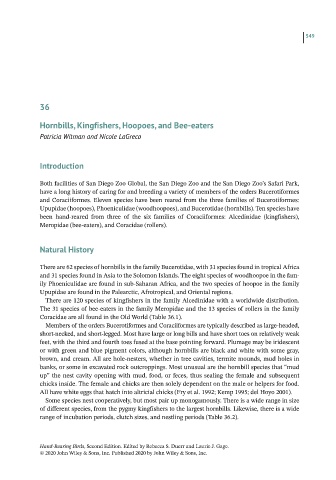Page 549 - Hand rearing birds second
P. 549
549
36
Hornbills, Kingfishers, Hoopoes, and Bee-eaters
Patricia Witman and Nicole LaGreco
Introduction
Both facilities of San Diego Zoo Global, the San Diego Zoo and the San Diego Zoo’s Safari Park,
have a long history of caring for and breeding a variety of members of the orders Bucerotiformes
and Coraciiformes. Eleven species have been reared from the three families of Bucerotiformes:
Upupidae (hoopoes), Phoeniculidae (woodhoopoes), and Bucerotidae (hornbills). Ten species have
been hand‐reared from three of the six families of Coraciiformes: Alcedinidae (kingfishers),
Meropidae (bee‐eaters), and Coracidae (rollers).
Natural History
There are 62 species of hornbills in the family Bucerotidae, with 31 species found in tropical Africa
and 31 species found in Asia to the Solomon Islands. The eight species of woodhoopoe in the fam-
ily Phoeniculidae are found in sub‐Saharan Africa, and the two species of hoopoe in the family
Upupidae are found in the Palearctic, Afrotropical, and Oriental regions.
There are 120 species of kingfishers in the family Alcedinidae with a worldwide distribution.
The 31 species of bee‐eaters in the family Meropidae and the 13 species of rollers in the family
Coracidae are all found in the Old World (Table 36.1).
Members of the orders Bucerotiformes and Coraciiformes are typically described as large‐headed,
short‐necked, and short‐legged. Most have large or long bills and have short toes on relatively weak
feet, with the third and fourth toes fused at the base pointing forward. Plumage may be iridescent
or with green and blue pigment colors, although hornbills are black and white with some gray,
brown, and cream. All are hole‐nesters, whether in tree cavities, termite mounds, mud holes in
banks, or some in excavated rock outcroppings. Most unusual are the hornbill species that “mud
up” the nest cavity opening with mud, food, or feces, thus sealing the female and subsequent
chicks inside. The female and chicks are then solely dependent on the male or helpers for food.
All have white eggs that hatch into altricial chicks (Fry et al. 1992; Kemp 1995; del Hoyo 2001).
Some species nest cooperatively, but most pair up monogamously. There is a wide range in size
of different species, from the pygmy kingfishers to the largest hornbills. Likewise, there is a wide
range of incubation periods, clutch sizes, and nestling periods (Table 36.2).
Hand-Rearing Birds, Second Edition. Edited by Rebecca S. Duerr and Laurie J. Gage.
© 2020 John Wiley & Sons, Inc. Published 2020 by John Wiley & Sons, Inc.

